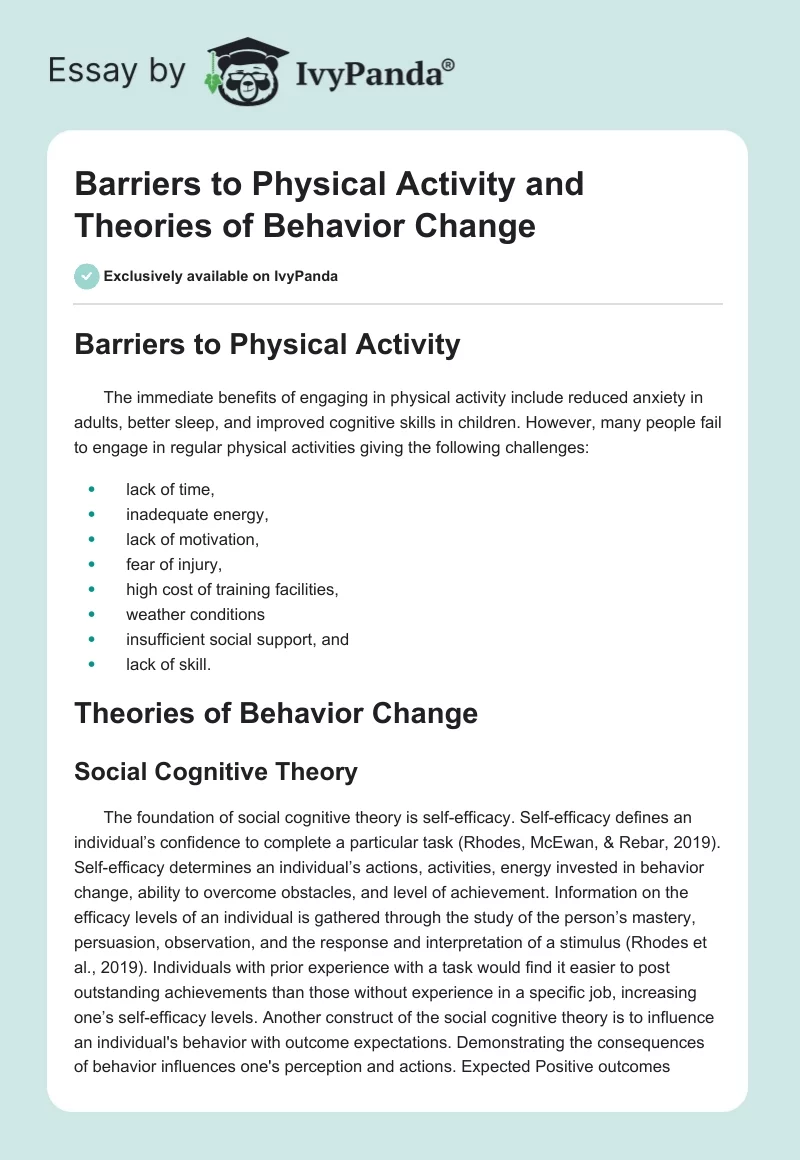Barriers to Physical Activity
The immediate benefits of engaging in physical activity include reduced anxiety in adults, better sleep, and improved cognitive skills in children. However, many people fail to engage in regular physical activities giving the following challenges:
- lack of time,
- inadequate energy,
- lack of motivation,
- fear of injury,
- high cost of training facilities,
- weather conditions
- insufficient social support, and
- lack of skill.
Theories of Behavior Change
Social Cognitive Theory
The foundation of social cognitive theory is self-efficacy. Self-efficacy defines an individual’s confidence to complete a particular task (Rhodes, McEwan, & Rebar, 2019). Self-efficacy determines an individual’s actions, activities, energy invested in behavior change, ability to overcome obstacles, and level of achievement. Information on the efficacy levels of an individual is gathered through the study of the person’s mastery, persuasion, observation, and the response and interpretation of a stimulus (Rhodes et al., 2019). Individuals with prior experience with a task would find it easier to post outstanding achievements than those without experience in a specific job, increasing one’s self-efficacy levels. Another construct of the social cognitive theory is to influence an individual’s behavior with outcome expectations. Demonstrating the consequences of behavior influences one’s perception and actions. Expected Positive outcomes usually affect positive behavioral change and motivate participants. On the other side, typical adverse effects generally demoralize the performance of any individual.
Humanistic Theory
The humanistic theory focuses mainly on human welfare, it strives to understand an individual and how people can achieve self-actualization. The humanism approach argues that an individual’s goal should take precedence over the coach’s goals (Rhodes et al., 2019). The theory suggests that the trainer should only act as a guide, and the trainers should exude empathy and understanding to the trainee’s feelings. As a result of the humanistic coaching, the individuals taking the physical activities remain passionate and enthusiastic during the exercise. Therefore, the approach significantly reduces the chances of burnout and makes that trainee self-aware and motivated to do even more.
Overcoming The Lack of Motivation
Many individuals cite lack of motivation as a primary cause of physical inactivity. Humans depend on a basis to carry out everyday tasks. However, it is usually frustrating and almost impossible to achieve set targets when one lacks zeal. I will employ the social cognitive theory to motivate my family members to engage more in physical activity through the expected outcome approach. For instance, I will present the advantages and disadvantages of physical activity. The presentation aims to motivate the family to be physically active to enjoy a better quality of life, prevent lifestyle diseases, and look and feel good. The exhibit also aims to discourage them from inactivity by demonstrating the effects of being vulnerable to incommunicable diseases such as type 2 diabetes. The presentation will trigger behavioral change and encourage more family members to engage in physical activities.
Overcoming the Fear of Injury
Many adults cite fear of injury as one of the leading causes of little inactivity. For instance, in my family, the parents usually dismiss physical exercises claiming they are too old and the training could injure their knees and back. However, physical activity does not guarantee an injury. Consequently, I will use the humanistic approach to behavior change to overcome this fear. The humanistic approach requires the trainer to be empathetic and understating to the trainees’ needs. Exercises do not have to be very complex and high impact, and however, simple approaches that are low impact also would achieve commendable results. Consequently, I would urge my parents to participate in long evening walks instead of jogging. I would also formulate low-impact standing exercises targeting the same muscles and outcomes as the high-impact muscles. Also, I would encourage them to strive to complete to take rests during the day and stretch, including yoga and Pilates in their physical activity routines.
Reference
Rhodes, R. E., McEwan, D., & Rebar, A. L. (2019). Theories of physical activity behaviour change: A history and synthesis of approaches.Psychology of Sport and Exercise, 42, 100-109.


